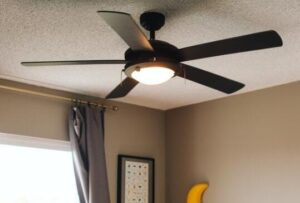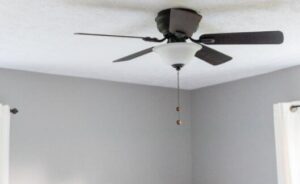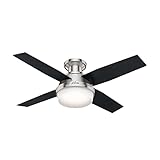A ceiling fan is a handy household appliance that uses an electric motor to rotate blades and promote air circulation in a room. As a result, it causes evaporative cooling on your skin necessary for the hot summer days.
It’s a cost-efficient alternative that uses less energy to bring about the cooling effect. As much as most people enjoy the luxury of a cold breeze in the skin, you probably don’t know the cost. Here is a detailed guide to keeping you informed.

How Much Does A Ceiling Fan Cost To Run? – How to Calculate?
Just like any other appliances, the energy consumption rates in a fan various based on various factors. The cost of electricity differs from one state to another, but on average, it’s about $ 0.13kWh. Your fan’s wattage and the length of time you use the fan also affects the cost. The wattage in a ceiling fan can range from 10 to 120 watts per hour. To know your fan’s capacity, check the power rating, either in watts or volts per amperes.
To quantify the amount used, let’s assume your fan’s capacity is 60 watts, assuming that your state uses the average electricity rate. On an hourly basis, 60 x 0.13= 7.8, divide the results by 1000 to get the kilowatts’ value. 7.8 ÷ 1000 = 0.0078. Hence, your ceiling fan costs you $0.0078 per hour of electricity usage.
If you use the fan for an average of six hours each day, your fan’s daily electricity usage is; 60 x6 =360 watts hours. Using the values mentioned above, you can calculate the everyday fan running cost by multiplying the average price per hour with the number of days. Hence the ceiling fan will cost you 0.0078 x 6= $0.0468 per day.
For a ceiling fan using an average of 360 watts each hour, then the usage for a month should be; 360 x30= 10800 watts. To get the units in kilowatts, divide it by a thousand. 10,800÷ 1000= 10.8 units. To calculate your monthly cost, take 10.8 x 0.13=$1.404. Further, to determine your annual usage, multiply $1.404 by 12 months to get $16.848.
Other Factors That Affects The Cost Of Running A Fan
The cost of electricity differs from time to time, affecting prices at various periods of the year. Consequently, the exact amount you spend to run a ceiling fan varies. The higher the electricity usage, the more the charges.

The using age
Additionally, the age of the fan affects the cost of running. For instance, an ancient model will use more electricity compared to a modern and energy-efficient one.
Dirt on the blades
Moreover, when dirt particles accumulate in your fan, it creates an extra load to the blades, and they have to work harder to produce the desired results. As a result, it consumes more energy. It will also depend on the fan size and speed settings. A bigger fan or if it runs at a faster speed consumes more power, resulting in higher electric bills. Most fans have three-speed settings, and as you increase fan speed, the higher the air resistance and the amount of air moved hence the high energy consumption.
Ceiling fan light
Another thing is the ceiling fan light. Those without the light appears to be more energy-efficient alternatives. However, if yours has the lighting functionality, you need to add each bulb’s wattage usage to your equation. The lighting fixture can consume anything from 13 to 190 watts.
Therefore, assuming that a brand uses around 30 watts for the lighting functionality, you multiply it by 0.13 to get 3.9, then divide it by a thousand. You might end up spending an additional $0.0039 on lighting per hour. In extreme cases, considering the 190 watts, you might have an extra bill of around $0.0247 each hour.
Tips To Minimizing Your Ceiling Fan Running Costs

#1. Rotate in right directions
You can make some low or no-cost changes to cut your fan’s energy consumption rate and electricity bills. First, ensure that your fan rotates in the right direction in various seasons. During summer, adjust it so that the fan blows in a counterclockwise direction. Stand below the fan and determine whether you can feel the cool breeze. If not, turn it off and set it to run in the opposite direction.
For winter, your fan should move low in a clockwise direction to recirculate warm air. If it rotates in the wrong direction, it leads to inefficiency and higher energy consumption.
#2. Turn it off immediately after use
On the other hand, turn off the fan while leaving the house. If you can minimize the time your fan runs, then you reduce the amount of electricity consumed. It will help you save on bills further.
#3. Avoid the fan with light fixtures
Although ceiling fans with lighting fixtures appear rather attractive, it would be wise to go for those without, to avoid the extra cost. Yet, you can make it more efficient by using energy-saving bulbs that use less energy.
How To Choose An Energy Efficient Ceiling Fan?
Look out for a fan with a sturdy motor to boosts the performance, reduce noise and wobbling. Remember, the fan will remain functional for a more significant time; thus, efficiency depends on the motor’s potential. The latest ones are the DC model, but you can still opt for the broad types exceeding 200mm.
CFM is the amount of air that your ceiling fan moves within a minute at maximum speed. The better the CFM, the more energy-efficient the device. However, some higher-level may need more energy; thus, try finding one ranging from 6000 to 7000.
Further, determine the diameter covered by the blades before buying a ceiling fan. The bigger room, the higher the fan width required. Also, consider the number and angles of your blades, essential in the functioning of your fan. Fewer blades are more efficient at an angle of about 12 to 14 degrees.
Top rated energy efficient ceiling fans you can choose:
Conclusion
Ceiling fans are very energy efficient tools to cool yourself at home without spending a lot of money. They consume less electricity to run, and you can save on energy further by applying the discussed hacks. Hopefully, the above piece answers your question on how much does a ceiling fan cost to run.










